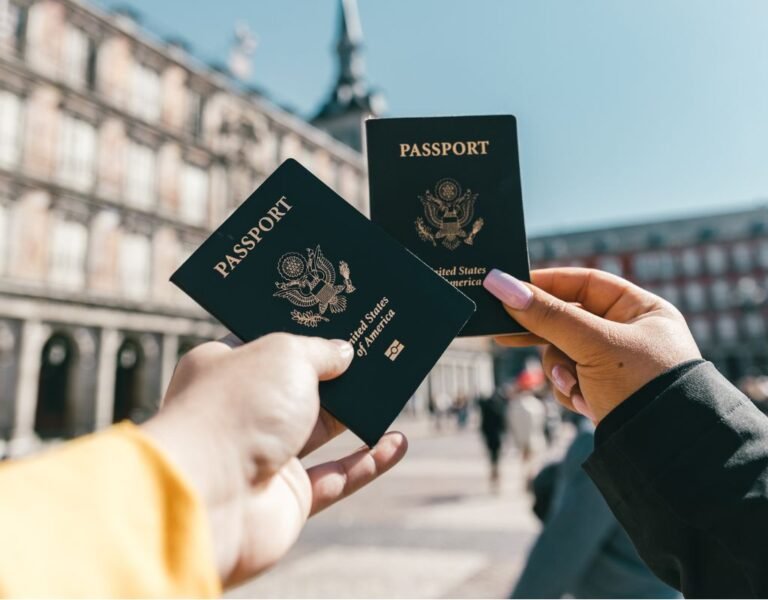Driving In France: Everything You Need To Know (2025)
|
Offering stunning countryside landscapes and culturally rich cities, France is a popular road trip destination year-round. Whether you’re a long-term resident or a temporary visitor on holiday, it’s important to be aware of the rules of the road when it comes to driving in France. Believe it or not, driving rules may differ slightly from your home country (take the United Kingdom and the United States, for example)!
In this blog, I will provide helpful tips for French driving, including the legal driving age, the best vehicle and rental insurance companies, how to buy a car in France, how to hire a car, speed limits, and more! It will help you hit the road more confidently and more prepared so you can have a more enjoyable road trip adventure!
Disclaimer: the advice, travel tips, and information in this blog post are not legally binding. This information was compiled with the intent to give tips and help people traveling navigate France’s driving laws.

Quick Overview Of Driving In France
I will go into greater details about driving laws in France throughout this blog post, but there are a handful of helpful facts that are especially important to keep in mind:
- France uses the metric system (kilometers and meters)
- 112 is the universal emergency number for the European Union. You can dial this number in the event of a roadside emergency in France. An operator will quickly connect you to nearby emergency services for that country.
- There are nearly 40 million passenger cars registered in France
- The legal driving age is 18 years old for a car, and 16 years old for a motorcycle
- Cars drive on the right side of the road (vs on the left side in the UK)
- More than 50 percent of cars sold in France are automatic, but many are still manual
- The standard speed limit on motorways is 80 mph (130 km/h)
- During foggy weather, the speed limit is reduced to 50 mph (80 km/h) on all roads
- The maximum legal level of alcohol in the blood for drivers of private vehicles is 0.05% (less than the U.S.’s 0.08%).
- Parking in front of fire hydrants, on roads with yellow curbs, or for more than 24 hours in the same place is not allowed. Long term parking is only allowed in long-term parking facilities.
- Children up to the age of 10 must travel in an approved child seat or restraint, adapted to their age and size.

French Driving Laws
France implements many of the typical driving laws that you might expect to encounter in most other countries. These include wearing a seatbelt, obeying stop signs, stop lights, and speed limits, and not driving impaired. However, below are some laws that are unique to driving in France:
👉🏻 Law 1: Mandatory Safety Items
You will see this mentioned a number of times throughout this blog post, but there are a number of safety items that are mandatory to carry in your car in France. Known as a Car Travel Kit, every person operating a four wheel vehicle has to have one. Inside, you will find a warning triangle, a reflective jacket or two, beam deflectors, a breathalyzer (France takes drunk driving very seriously) and a UK sticker for cars registered in the UK. These items aim to help drivers operate cars safely, and prepare for unexpected breakdowns, accidents, or other emergencies.
👉🏻 Law 2: Clean Air Stickers
If you are planning to travel to certain cities throughout France (such as Paris), your car will need to have a Clean Air sticker on it. Also known as a Crit’Air, this helps identify cars that could be environmentally damaging in urban areas called Low Emission Mobility Zones (ZFE-m). This law exists in order to help reduce CO2 emissions in France’s major cities. If you fail to put a Clean Air sticker on your car in a ZFE-m, you could face a fine of 68 euros or more.
👉🏻 Law 3: Use of Warning of Approach
While some countries might have free use of their car horn (I’m looking at you, America), in France, it’s completely different. Horns may only be used if absolutely necessary, and to give other drivers safety warnings. Otherwise, warning must be given by flashing passing lights during the daylight hours. In highly populated areas, the use of the horn is prohibited unless to avoid immediate danger. The use of other devices such as sirens and whistles is strictly prohibited.
👉🏻 Law 4: The Traffic Light System
France uses the international three-color traffic light system. It’s very similar to the United States’ traffic light system. However, the traffic lights are typically located on the side of the road rather than above it. Like in the United States, a flashing yellow or amber light indicates to “proceed with caution” and give way to vehicles coming from the right.
A flashing red light indicates that entry to a particular road is not permitted. In France, it may also indicate an emergency vehicle route or exit. In France, you are not allowed to turn right on a red light in any circumstance. Sometimes, a red light will be accompanied by a yellow arrow, which means you can proceed in the direction of the arrow unless otherwise indicated. Keep in mind that while doing so, you have to give the right of way to pedestrians and vehicles traveling in the same direction.
👉🏻 Law 5: No Speed Camera Detectors
Some countries allow free use of apps or other software that provide alerts regarding speed traps or cameras (this also applies to America). However, French law prohibits its drivers from using such devices or software to warn drivers of their location. If caught using one of these apps or devices while driving in France, you could face a very large fine of €1,500. It might be tempting, but the best thing to do is simply obey the speed limits of the roads and you’ll be just fine.

Driving In France Tips
It’s well known the laws are laws, and they can’t be manipulated or broken. However, there are plenty of helpful tips you can utilize that will make following the driving laws in France much less stressful. Below are many that I have utilized in the past when driving in France:
📌 TIP 1: Get an International Driving Permit
If you plan to drive or take your car abroad, some countries require or highly recommend getting an International Driving Permit (IDP). This especially rings true for drivers from the UK. While it’s not legally required to have an IDP to be a driver in France, it is recommended. Having an official document in French will make things easier in the unlikely event you get pulled over, break down, or have an accident. To obtain an IDP, you must be at least 18 years old, and you can’t apply for one more than three months before your travel date. In most cases, you can easily apply for an IDP online. For Americans, you fill out an application form through AAA at a cost of $20 USD. Keep in mind that the IDP is in addition to the valid drivers license from your home country. It is not a replacement for your home country’s drivers license.
📌 TIP 2: Drive a Smaller Fuel-Efficient Car
Both gas and toll roads are very expensive in France. France also puts a particular focus on environmentally friendly transportation options and alternatives (hence the Clean Air stickers). For these reasons, a lot of drivers in France choose to operate smaller, more fuel-efficient vehicles. French roads can also be extremely narrow and winding, especially in the countryside and in smaller towns and villages. For safety reasons, and to ensure more comfortable driving, operating a smaller car is recommended. Also keep in mind that many smaller cars in France are manual and not automatic. You will be able to find automatic cars in France, but there is a limited amount. If you are renting a car and need an automatic, it’s best to do it months in advance.
📌 TIP 3: Get to Know the Speed Limits & Signage
While many of France’s rules of the road are similar to that of other countries, their road signs look much different. Their speed limits also vary depending on road conditions, weather, and the type of road (motorways, carriageways, less developed roads). Prior to arriving in France, take some time to study what each sign means. Speed limits are a bit less difficult to grasp, but there are some slight differences. The graph below is extremely helpful:
| Motorways | Priority roads and dual carriageways | Other roads | Built up areas | |
| Normal traffic conditions | 130 km/h | 110 km/h | 80 km/h | 50 km/h |
| Rain or other precipitation | 110 km/h | 100 km/h | 70 km/h | 50 km/h |
| Visibility less than 50m | 50 km/h | 50 km/h | 50 km/h | 50 km/h |
📌 TIP 4: Be Prepared for the Roads
French roads are typically in very good shape, especially the major highways. It’s not surprising that the toll roads themselves are even more maintained. However, smaller roads in the countryside and around sparsely populated areas may present less than ideal conditions. It’s also important to pay attention to the roads you’re driving on, especially at night. In the countryside, roads can be unexpectedly narrow and winding. Stay off your cell phone and limit distractions when driving on these types of roads.
📌 TIP 5: Avoid Toll Roads
France has many toll roads. In fact, more than 76% of its motorways have tolls on them (about 90 or so in total)! This also includes toll bridges. Even the Fréjus road tunnel, the Mont Blanc road tunnel, and the Maurice Lemaire tunnel are subject to tolls.
The good news is that it is possible to avoid these tolls. Plan out your trip ahead of time to take “N” and “D” roads. “N” roads are “Route Nationale” (National Roads) that are major highways and usually longer and faster. “D” roads are “Route Départementale” (Departmental Roads). These roads are shorter, slower, and more local roads within a specific region.
If you absolutely can’t avoid a toll, the cost of each one varies by region, and there are numerous ways to pay them. You can pay at the toll booth with credit cards, debit cards, or with cash. If you want to pay with a credit card, look for a lane with a green arrow or a credit card symbol above it. If you want to pay with cash, you can do so at a manned toll booth.
Keep in mind that if you do pass through a toll and don’t pay within 72 hours, you’ll receive a notice with a surcharge of 90 euros. If you pay within 15 days, the penalty is reduced. If you don’t pay within 70 days, you’ll receive a class IV fine of 375 euros or more.
📌 TIP 6: Know Where to Park
Parking laws in France are very similar to parking laws in the U.S., if not identical. In French cities, you will often need to pay to park. If you’re unsure if you have to pay, look for a sign that says “PAYANT”. If you see one, head to a nearby meter or automatic machine. You’ll need to make the ticket from the machine visible from inside your car windshield. There are handicap parking spaces available, and in some cities, they are even free of charge. Overnight parking is not permitted anywhere in France with the exception of rest areas. As in the United States, failure to pay for a parking permit will result in a fine. France does utilize both surveillance cameras and parking sensors to detect violations, so don’t think they are bluffing!

Hiring A Car In France
If you’re only planning on visiting France for a temporary stay (less than 90 days), a rental car is a great option! If you’re from the U.S. on a tourist visa, you can even operate a vehicle with a valid U.S. driver’s license! As I mentioned previously, it’s highly encouraged to also get an IDP in French for translation purposes.
Most importantly, to hire a car you must be at least 21 years old or 25 years old. It varies by car rental company. You must also have a credit card in your name to match the reservation if you are the driver.
Be sure to book your car at least four months in advance of your trip to save money and get the best deals. Otherwise, you run the risk of paying thousands of dollars up front, or not getting a car at all. Dozens of car rental companies are located throughout France, especially at airports and railway stations.
I personally recommend DiscoverCars.com. They have a wide range of vehicles available and more than 20,000 locations. You’re also more than likely to get the best deal using DiscoverCars.com.
One thing to keep in mind is that both gas and toll roads are much more expensive in France than many other countries. This is why avoiding toll roads and driving fuel efficient cars is so important!
Buying A Car In France
If you plan to be in France on a long-stay visa (longer than 90 days), you might consider buying a car. France has an excellent public transportation system, but purchasing a car offers convenience and freedom to explore. However, knowing when, where, and how to buy a car in France can be a bit overwhelming. But don’t worry – that’s why I’m here!
You first need to determine your budget, as well as the make and model of the car you want. The best places to buy a car are at dealerships for that specific car brand. If your budget allows, I would recommend getting a slightly used car to decrease the overall price and insurance rates.
For payment, it’s common for dealerships to require a 50 percent deposit followed by a set payment plan. At the same time, you can also register and pay taxes on your car. This can usually be facilitated by the car dealer. The cost varies depending on the make and model. However, registration on a new private vehicle is usually around 240 euros.
Perhaps equally as important, you will need to purchase a private car insurance policy. The overall cost of car insurance is heavily based on your age, vehicle, gender, location, and type of plan. The average cost of a comprehensive insurance policy is €850, but there are more affordable options. You just have to shop around for the best deal!
Frequently Asked Questions About Driving in France
To drive in France you’ll need a valid driver’s license (and an IDP if you’re not a resident of France), your passport, proof of private car insurance and car registration, and a European Car Travel Kit. The travel kit includes a warning triangle, a reflective jacket, beam deflectors, and a UK sticker (for vehicles registered in the UK). If you are traveling to select cities, you will also need a Clean Air Sticker. These stickers indicate the level of air pollution the car emits.
Aside from a few additional laws, driving in France is relatively straightforward.The traffic lights are on the side of the road, and road signage looks much different. You will need to pay close attention to these at first until you memorize them and become more comfortable with driving.
It is mandatory for cars with at least four wheels to carry one warning triangle. However, it’s recommended to carry two or more warning triangles in case of emergencies.
You must carry a warning triangle (or a few), and reflective safety jackets. Other items that come with a Car Travel Kit are breathalysers to check your blood alcohol level, high beam deflectors, and a first aid kit.

Conclusion
Overall, driving in France isn’t something to get overly nervous or worried about. Many of their driving laws are common sense laws that are enforced in dozens of countries around the world. That being said, it’s important to review the fine details and pay attention to speed limit signs, French road signs, and traffic lights. If you use this detailed blog as your guide, you will be taking epic road trips while driving in France safely and confidently in no time!
Hello and Welcome!

We started our family travel blog in hopes of supporting other families move abroad and travel the world. Through straightforward, sincere and supportive information we hope to provide a reliable guide for those moving overseas with a family and traveling the globe.





